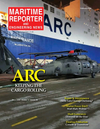
Page 38: of Maritime Reporter Magazine (February 2024)
Read this page in Pdf, Flash or Html5 edition of February 2024 Maritime Reporter Magazine
TECH FEATURE
Ammonia and the 15,00
A project initiated by Seaspan Corporation and the Mærsk
Mc-Kinney Møller Center for Zero Carbon Shipping (MMMCZCS) has set out to develop a design for a large 15,000-TEU ammonia-fueled container vessel.
Image Seaspan Corporation/Foreship
By Greg Trauthwein orking with ship designer Foreship and the in large quantities for various industrial purposes,
American Bureau of Shipping (ABS), Sea- and it is widely traded, making it a practical option span Corporation continues work to develop for shipping.
Wa concept design for a 15,000-TEU container While Seaspan Corporation is a driver in the development ship, a design which received an Approval in Principle (AiP) of the 15,000 TEU ammonia fueled containership, the com- from ABS last summer. pany is fuel agnostic, exploring many options, and is in fact
It is universally agreed that there are no 'silver bullet solu- in the midst of receiving a new series of 25 LNG dual-fueled tions' when talk turns to decarbonizing the maritime sector and containerships, as Seb Brindley, Senior Naval Architect, Sea- ammonia certainly has its drawbacks, led by the caustic nature span Ship Management, explains. “We need to be ready for of the fuel itself as well as the fact that the engine fueled by the future and have the capability to handle whatever fuel ammonia is still under development. That said, there are com- our clients require. The clear advantage for ammonia is that pelling arguments to be made for ammonia, and some see am- there's no carbon involved in its molecule, it's just nitrogen monia as a leading alternative fuel as the mid-2030s, based on: and hydrogen. So it is a scalable alternative fuel that doesn't • Low Emissions: Ammonia combustion produces have a carbon factor. Of course, when burning, we need to nitrogen and water as its primary byproducts, worry about laughing gas [Nitrogen oxide (NOx) emissions], which means lower emissions of greenhouse gases which does have a greenhouse effect,” an impact that should and particulate matter. be addressed either through engine design or after treatment.
• Renewable Production Potential: “Green” Ammonia While ammonia itself is without carbon, there is the need can be produced using renewable energy sources, for a pilot fuel to start the combustion process. “The engine such as wind or solar power, through electrolysis. manufacturers are looking at a pilot fuel to help kickstart the • Energy Density: Ammonia has a high energy density, ignition in the engine, and the pilot fuel, depending upon which means it can store a signi? cant amount of where it comes from, may have a carbon factor associated energy per unit of volume. with it,” said Brindley. • Established Infrastructure: Ammonia has an According to Jan-Erik Räsänen, CTO, Foreship, the prospect established infrastructure for production, storage, of generating ammonia using renewable energy sources makes and transportation. the prospect of ammonia in maritime even more attractive. “If • Global Availability: Ammonia is globally produced you do E-ammonia, going through the hydrogen, you don't have 38 Maritime Reporter & Engineering News • February 2024
MR #2 (34-44).indd 38 2/7/2024 2:34:26 PM

 37
37

 39
39
